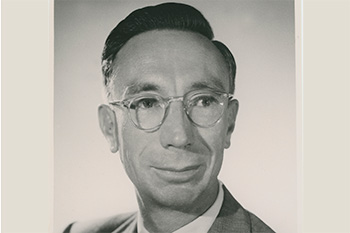A new biography, Joe Pawsey and the Founding of Australian Radio Astronomy, examines the life and career of an Academy foundation Fellow.
The book follows Dr Joseph Lade Pawsey FAA FRS (1908–1962) from humble beginnings in country Victoria through a unique career shaped by the challenges and opportunities of his generation.
It is freely available online as open access, or can be purchased as a hard copy from the publisher, Springer Nature.

The biography examines Dr Pawsey’s critical role in the development of radar during World War II and his leadership in transitioning the CSIR Division of Radiophysics to peacetime projects. It explores the birth and growth of radio astronomy and explains how an isolated continent with limited resources became a world leader in the field.
The book shows Dr Pawsey’s talent for mentoring young scientists, many of whom became innovators in their own right, and describes his work with Ruby Payne-Scott and Lindsay McCready on the connection between sunspots and increased radio emissions from the sun.
It covers the development of aperture synthesis and the following controversial disagreement with Sir Martin Ryle, who was later awarded the Nobel Prize in Physics in 1974, while exploring the connection between prominent international astronomers and Australian engineers and physicists who developed and advanced the field.
I was only 17 when Dad died, but the book has brought him back to life for me, as a successful international scientist who has been described as the ‘father of Australian radio astronomy’. His biography re-introduced me to my complete father, a man I’d previously only known as ‘Dad’.
— Hastings Pawsey
Dr Pawsey received many honours during his lifetime. In 1954 he was elected to the Fellowship of the Royal Society, London, and was made a Foundation Fellow of the Australian Academy of Science. He received the Thomas Ranken Lyle Medal from the Australian National Research Council in 1953. In 1957, he was the Academy’s first Matthew Flinders Medal Lecturer, and was awarded the Hughes Medal from the Royal Society in 1960. The Pawsey Medal, recognising outstanding contributions to research in physics, was the second medal struck by the Academy and was named in his honour.
The process of gathering material for the book took almost 20 years—with co-author Dr W M Goss, who was awarded the Pawsey Medal in 1976, having approached Dr Pawsey’s youngest son Hastings around the year 2005 with the possibility of writing a book about his father.
Hastings Pawsey said this was the opening of a ‘Pandora’s box’, prompting him to begin exploring the family archive with the help of his wife Liz.
Dr Goss, Dr Claire Hooker and Professor Ronald D Ekers AO FAA FRS drew extensively from these primary sources, including previously unreleased material in the care of the Pawsey family, building a portrait of as a person as well as a scientist.
The resulting biography is a comprehensive and often personal account of the whole of Joseph Pawsey: his experiences, philosophies, and place in the history of 20th century science.
The research and experience of Australian scientists forms the foundation on which we build our future. It is vital that we capture and preserve their stories. Donations from organisations and individuals are welcome; if you would like more information about supporting the archive project, please contact our Philanthropy Manager at philanthropy@science.org.au
© 2025 Australian Academy of Science